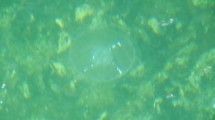Abstract
The conditions under which covering (“decorating”, “masking”) takes place have been studied in the sea urchins Paracentrotus lividus, Psammechinus miliaris and 2 other species. Covering occurs equally in darkness or light. It requires suitable objects and locomotion or searching activity of the tube feet. The covering reaction which may follow chemical, mechanical or optical stimuli may be purely the result of an increase in locomotory or general activity. Initial selection of different covering objects depends on the tube feet reflexes; size, form and weight of the object are important. Whether an object is accepted or not, depends on its surface and structure, the amount of water movement and the general activity level of the sea urchin. Transparency and colour of an object do not appear to be important. It is suggested that the covering process can be explained in terms of local tube feet and spine reflexes. The loading-up of objects may be understood as “relative walking”: the same reflexes which move the urchin on stable ground, draw loose particles towards the animal and then upwards.
Zusammenfassung
-
1.
Es wurden die Bedingungen untersucht, unter denen Bedeckung (“Maskierung”) bei den Seeigeln Paracentrotus lividus, Psammechinus miliaris und 2 anderen Arten auftritt.
-
2.
Eine Bedeckung kann sowohl im Dunkeln als auch im Hellen stattfinden. Sie setzt das Vorhandensein passender Objekte und einer Lokomotionsaktivität des Seeigels bzw. einer Suchktivität seiner Ambulacralfüßchen voraus.
-
3.
Da Bedeckung auch auf chemische und mechanische Reizung hin auftreten kann, ist sie sehr wahrscheinlich keine spezifische Lichtschutzreaktion sondern das Ergebnis einer allgemeinen Steigerung der Lokomotions- bzw. Füßchenaktivität.
-
4.
Eine scheinbare Auswahl zwischen verschiedenen Bedeckungsobjekten kann durch die Funktion der Füßchen und Stacheln geschehen. Größe, Form, Gewicht, Struktur und chemische Beschaffenheit der Objekte spielen eine Rolle. Ob ein aufgenommenes Objckt behalten wird, hängt zudem noch vom Ausmaß der Wasserbewegung oder der allgemeinen Aktivität des Tieres ab. Durchsichtigkeit und Farben von Objekten sind nicht von Bedeutung.
-
5.
Die Bedeckungsreaktion wird auf der Ebene von Füßchen- und Stachelreflexen erklärt. Das Aufladen der Objekte kann als “relatives Kriechen” verstanden werden: Dieselben Reflexe, die das Tier auf festem Grund vorwärtsbewegen, ziehen lose Partikel an das Tier heran und laden sie auf.
Similar content being viewed by others
Zitierte Literatur
Anton, H.: Die Koordination der Saugfüßchenreflexe der regulären Echiniden. Ein Beitrag zur Zentrumsfrage. Z. vergl. Physiol. 5, 801–816 (1927).
Boone, L.: Echinodermata from tropical East American seas. Bull. Bingham oceanogr. Coll. 1, 1–22 (1928).
Brehm, A. E.: Tierleben, 4. Aufl. Ed. by O. zur Strassen, Vol. 1. Die niederen Tiere, 722 pp. Leipzig: Bibliogr. Inst. 1918.
Camerarius, J.: Symbolorum et Emblematum... Cent. IV. Francofurti 1654.
Clark, H. L.: Report on the Echinoidea collected by the Barbados Antigua Expedition from the University of Iowa in 1918. Stud. nat. Hist. Iowa Univ. 9, 103–121 (1921).
Diebschlag, E.: Ganzheitliches Verhalten und Lernen bei Echinodermen. Z. vergl. Physiol. 25, 612–654 (1938).
Dohrn, A.: Mittheilungen aus und über die zoologische Station von Neapel. Z. wiss. Zool. 25, 457–480 (1875).
Dubois, M. R.: Action de la lumière sur les échinodermes. Int. Congr. Zool. 9, 148–151 (1914).
Gamble, J. C.: Some observations on the behaviour of two regular echinoids. In. Proc. Symposium of the Underwater Association for Malta, pp. 47–50. Ed. by J. N. Lythgoe and J. D. Woods. Malta: 1965.
Harvey, E. B.: The American Arbacia and other sea urchins. 298 pp. Princeton: University Press 1956.
Kinosita, H. J.: Conduction of impulse in superficial nervous system of sea urchin. Jap. J. Zool. 9, 221–232 (1941).
Lindahl, P. E. und J. Runnström: Variation und Ökologie von Psammechinus miliaris (Gmelin). Acta zool., Stockh. 10, 401–484 (1929).
Märkel, K. und R. Maier: Beobachtungen an lochbewohnenden Seeigeln. Natur Mus., Frankf. 97, 233–243 (1967).
Millott, N.: The covering reaction in a tropical sea urchin. Nature, Lond. 175, 561 (1955).
— The covering reaction of sea urchins I. A preliminary account of covering in the tropical echinoid Lytechinus variegatus (Lamarck), and its relation to light. J. exp. Biol. 33, 508–523 (1956).
—: Coordination of spine movement in echinoids. In: Physiology of Echinodermata, pp 465–485. Ed. by R. A. Boolootian. New York: Wiley 1966.
Mortensen, T.: A monograph of the Echinoidea M III, 2 and III, 3. Copenhagen: Reizel 1943.
Orton, J. H.: On the occurrence of Echinus esculentus on the foreshore in the British Isles. J. mar. Biol. Ass. U.K. 16, 289–296 (1929).
Petit, G.: Localisation et comportement de quelques espèces d'échinodermes sur les récifs madreporique de Tuléar (Madagascar). C. r. somm. Séanc. Soc. Biogéogr. 56, 56–59 (1930).
Scheer, G.: Nachweis von Lichtsinnesorganen bei Seeigeln durch deren Bedeckungsreaktion. Naturwissenschaften 43, 501–502 (1956).
Uexküll, J. Von: Die Physiologie des Seeigelstachels. Z. Biol. 39, 73–112 (1900).
Yoshida, M.: Photosensitivity. In: Physiology of Echinodermata, pp 435–464. Ed. by R. A. Boolootian. New York: Wiley 1966.
Author information
Authors and Affiliations
Additional information
Communicated by O. Kinne, Hamburg
Rights and permissions
About this article
Cite this article
Dambach, M., Hentschel, G. Die Bedeckungsreaktion von Seeigeln. Neue Versuche und Deutungen. Marine Biology 6, 135–141 (1970). https://doi.org/10.1007/BF00347243
Accepted:
Issue Date:
DOI: https://doi.org/10.1007/BF00347243




